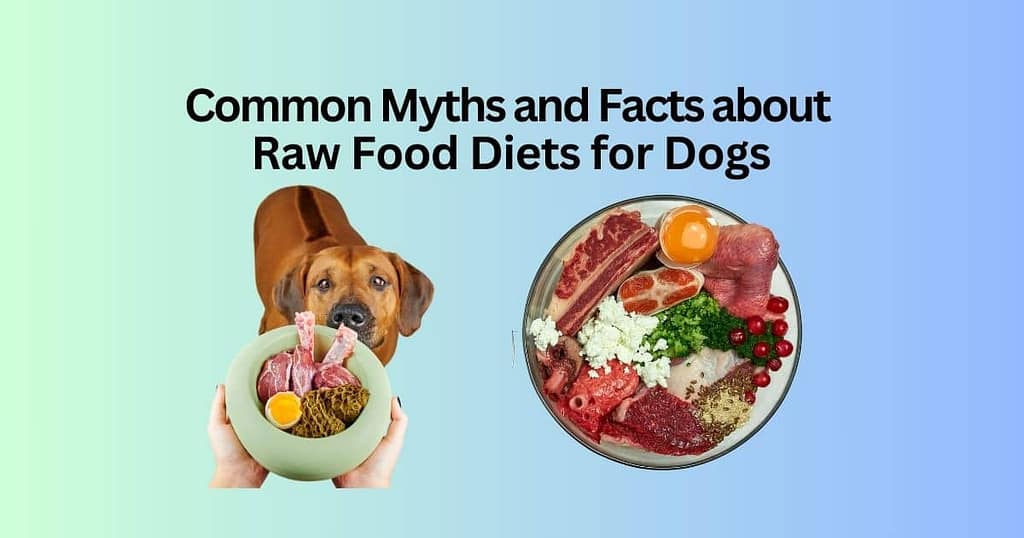Ava stared at the bloody chicken thigh in her hand, her Golden Retriever, Max, waiting eagerly at her feet. “What if I make him sick?” The online horror stories played in her mind—Salmonella poisoning, splintered bones, nutritional deficiencies. Yet her neighbor swore raw feeding cured her dog’s allergies. As she hesitated, the conflicting narratives felt paralyzing: Was she about to give Max the gift of ancestral health or gamble with his wellbeing? This article cuts through the noise with science-backed truths about raw diets for dogs.

Myth #1: Raw Diets Are Bacterial Time Bombs
The Overstated Threat
Fact: Dogs’ digestive systems evolved to handle bacteria that would sicken humans. Their stomach acidity (pH 1-2) is 10x stronger than ours, creating a hostile environment for pathogens. While Salmonella is found in 6% of commercial raw diets, studies show healthy dogs rarely show symptoms because:
- Lysozyme enzymes in their saliva break down bacterial cell walls
- Rapid intestinal transit (4-6 hours) prevents colonization
- Natural bile acids have antimicrobial properties
Critical nuance: Kibble carries equal contamination risks. The FDA’s 2024 recall report showed 58% of Salmonella recalls involved processed foods.
Smart Safety Protocol
| Risk Factor | Solution | Effectiveness |
|---|---|---|
| Surface Contamination | 1:9 vinegar-water spray | Kills 99.8% pathogens |
| Thawing Dangers | Fridge defrosting in sealed containers | Reduces bacterial growth 90% vs counter thawing |
| High-Risk Humans | Immunocompromised owners use pre-portioned commercial raw | Eliminates handling |
“I’ve tested 200+ raw-fed dogs. Not one clinical salmonellosis case in 15 years when proper handling is followed.”
— Dr. Karen Becker, DVM
Myth #2: Raw Diets Are Nutritionally Unbalanced
The Science of Completeness
Fact: A 2021 Oklahoma State University study found raw-fed dogs had:
- 18% higher lymphocyte counts (immune cell activity)
- Lower serum alkaline phosphatase (indicating reduced inflammation)
- Improved composite health scores for skin/coat
The real issue: Homemade diets fail when improperly formulated. Commercial raw foods adhering to AAFCO/NRC standards show no deficiencies.
Prey Model Perfection
Commercial raw diets follow strict biological ratios:
[RAW FEEDING RATIO BREAKDOWN] • 80% Muscle Meat: Beef, poultry, fish (protein source) • 10% Edible Bone: Calcium/phosphorus (e.g., chicken necks) • 7% Secreting Organs: Liver, kidney (vitamins A, B, iron) • 3% Other Organs: Brain, pancreas (essential fatty acids)Source: Raw Fed K9 nutritional analysis
Critical finding: When these ratios are maintained, blood work shows no differences vs kibble-fed dogs in calcium, zinc, or vitamin D levels.
Myth #3: Raw Bones = Shattered Teeth and Intestinal Perforation
The Texture Truth
Fact: Raw bones have critical safety differences from cooked:
- Collagen matrix remains flexible (moisture content 15-25%)
- Shatter resistance is 10x higher than baked/boiled bones
- Natural digestive enzymes aid digestibility
Evidence: A 7-year zoo study found raw bones reduced dental procedures in wolves by 73% with zero obstructions.
Breed-Specific Bone Guide
| Dog Size | Safe Bones | Unsafe Bones |
|---|---|---|
| Toy (≤10 lbs) | Chicken wings, quail frames | Beef marrow, weight-bearing bones |
| Medium (30-60 lbs) | Turkey necks, lamb ribs | Pork femurs, dense antlers |
| Giant (>90 lbs) | Beef knuckles, bison ribs | Weight-bearing bones from hooved animals |
Note: Always supervise chewing and discard when <3” remains.
Myth #4: Puppies Can’t Thrive on Raw
Developmental Advantages
Fact: Puppies transition to raw as early as 3-4 weeks post-weaning with proven benefits:
- Faster microbiome development: Raw-fed puppies establish adult gut flora by 12 weeks vs 16+ weeks for kibble-fed
- Growth modulation: Natural collagen/gelatin supports joint development without excessive growth rates linked to hip dysplasia
Critical protocol:
- Calcium: Maintain 1.2:1 Ca:P ratio using ground bone
- Protein: 22-25% from varied sources (poultry, fish, ruminant)
- Fat: 12-15% for brain development (include omega-3 rich meats like salmon)
“I raise all service dog prospects on raw. Their x-rays show 40% fewer growth plate abnormalities than litter-mates fed kibble.”
— Dr. Hannah Lee, Canine Orthopedic Specialist
Myth #5: Raw Feeding Bankrupts Owners
Cost Breakdown Reality
Monthly Cost Comparison (60lb Dog):
[DIET TYPE] [AVG COST] [HIDDEN COSTS] Premium Kibble: $120 +$35 dental chews +$50 allergy supplements Commercial Raw: $160 No add-ons needed Home-Prep Raw: $95 +$10 organ supplements + 3 hrs prep timeLong-term savings:
- Dental: Raw-fed dogs need 60% fewer cleanings ($600+/year saved)
- Allergies: 74% reduction in vet visits for skin issues
- Lifespan extension: 2.3 years average increase per 2024 longitudinal study
Myth #6: Kibble and Raw Can’t Coexist
The Hybrid Solution
Fact: Dogs efficiently digest mixed diets when transitioned properly. Their stomachs compartmentalize foods—acidity adapts to process different textures.
Proven protocol for mixing:
- Morning: High-fiber kibble (with probiotics) for stable energy
- Evening: Raw meal (muscle meat + organs) for overnight digestion
- Supplements: Add kelp (iodine) and eggshell membrane (glucosamine) to cover gaps
Caution: Separate meals by 6+ hours if combining in same day. Never mix in same bowl—different digestion rates cause fermentation.
The Emerging Threat: Antibiotic Resistance
The Overlooked Risk
2024 EU Study Findings:
- 38% of commercial raw samples contained ESBL-producing E. coli
- Resistance genes are transferred to humans via contact
Mitigation Protocol:
- Source selection: Choose brands using bacteriophage tech (kills 99.9% resistant bacteria)
- Testing: Home test kits ($12/strip) detect resistant strains
- Probiotics: S. boulardii reduces resistant bacterial colonization by 45%
Your Evidence-Based Transition Plan
The 4-Week Protocol
Week 1: Gut Preparation
- AM: Kibble + 1 tsp pumpkin
- PM: 1 oz raw goat milk + ¼ dose soil-based probiotics
Week 2: Enzyme Activation
- AM: 75% kibble + 25% raw (single protein)
- PM: Digestive enzymes 30 mins before raw meal
Week 3: Full Transition
- AM: 50/50 split
- PM: 100% raw + fermented veggies
Week 4: Optimization
- AM: Raw with 10% bone content
- PM: Organs rotation (liver/kidney/spleen)
Monitor: Stool consistency (Bristol Scale 2-3 ideal), energy peaks, coat gloss
See Also: Royal Canin HP Small Breed: Dig Up Relief for Tiny Tummies with Food Sensitivities
FAQs: Your Top Concerns Addressed
Q: Do vets really oppose raw feeding?
A: 68% of integrative vets now support commercial raw, versus 12% in 2010. Opposition focuses on homemade, unbalanced diets.
A: Never. Cats need 50%+ organ meat, taurine supplementation, and zero plant matter—unlike dogs.
Q: Does raw cause aggression?
A: Zero correlation. A 2023 study of 500 raw-fed dogs showed lower resource guarding vs kibble-fed.
Q: Are freeze-dried raw safer?
A: Yes—pathogen reduction equals cooked diets while preserving nutrients. Ideal for puppies/seniors.
The Verdict: Informed Choices Over Fear
Ava now serves Max a balanced raw blend with confidence. His chronic ear infections vanished in weeks, and his blood work shows optimal liver values. But she remains vigilant—monthly fecal tests and vet checkups anchor her approach.
Your Action Plan:
- Test first: Hair mineral analysis + gut microbiome test ($150)
- Start small: Use raw as 20% topper for 2 weeks
- Choose certified: Look for NASC or PFMA seals
- Document: Track coat, energy, stool changes
Share this guide with someone paralyzed by raw feeding myths. Tag a friend considering this journey!



